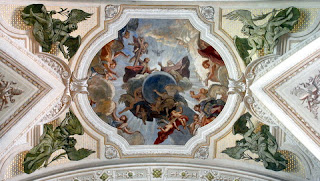

Reading the tourist information leaflets last night, we decided that we would like to go part way up the west coast of Lake Balaton before going off to Slovenia. We wanted to visit the Tihany peninsula and a Roman villa, just a little further North.
As normal, we left later than intended after being let through a locked gate to get the the grey water dumping point on a stretch of grass between the campsite fence and a drainage ditch. On an otherwise very well organised campsite, this was bizarre.
On to Tihany and its Benedictine abbey with a crypt that was originally part of an earlier Roman building and now houses a grave of a King Andrew I of Hungary, the founder of the abbey. The site also had wonderful views over Lake Balaton.
Lunch was taken on the shores of Balaton and then it was on to the Roman villa (Nemes Vamos) - it was closed! Only open from May to September said the notice. It would have been helpful if the Tourist Information staff in Keszethely had told us that but, given that they didn't know where the villa was and had to look it up on Google Earth, it wasn't surprising that they didn't know about the opening times. However, the site itself was effectively open and we were able to wander around unhindered. The parts that were closed were the museum and the reconstructed buildings, but it was easy to gain a good understanding of the site. Definitely worth a visit if we are in the area when it is open.
Before we started on The Odyssey, we agreed on a rule – never intentionally arrive at a site in the dark, preferably arriving before 17:00. We broke that rule this day and regretted it! The rule was very sensible as it allowed for unexpected delays and gave a chance for us to find an alternative site should our intended site be closed.
The journey started OK until we went beyond Balaton towards the Slovenian border. The road was the most sustained stretch of bad road that we had so far encountered. It was badly maintained with a very uneven surface as well as being twisty – slow and uncomfortable driving. However, we reached the border without incident, but later than we intended and it was well and truly dark.
There was construction work on the Slovenian side preparing extra customs lanes but this was nothing compared with the Croatian side. They were building a new motorway and it was total chaos. We were expecting to be able to go into the town of Lendava directly from the border but were instead forced to go onto the unfinished motorway over dirt tracks and one enormous pothole that made Henrietta's body twist in ways that she did not like! We then went for miles down the unfinished motorway in what appeared to be the wrong direction. Finally, with great relief we came off that road and found a temporary sign that mentioned Lenvada. We followed it over fields, or so it seemed! The road was simply dirt between kerbs that were to border the new road and in the pitch black (no street lights), no road markings and lorries heading straight for us, it was quite unerving. I suppose that going round roundabouts in a clockwise direction (as in Britain) should have felt comforting but it didn't, especially when there was barely enough room for the lorries to pass us. Fortunately, we soon found a sign to the campsite that we were looking for – 'Campingplatz Lipa Terme'. Very few sites in Slovenia are open in October and, given that the next site was many miles away, we were praying that this one was open as the book suggested. We went down the unlit, partly constructed road, finding the Hotel Lipa Terme but no sign of a campsite. The only road that went further was in an even worse state of partial construction and appeared to have a barrier across part of it. At this point I decided that we would ask at the very posh hotel. We parked in their car park and went into reception to join the many wealthy, bejewelled guests. To our amazement, they said that the campsite was down the road that I had rejected and that the hotel was the reception point. We thankfully booked in and were despatched with their man who would turn on our electricity. When we arrived at the site, we were again amazed. Far from being closed, or nearly deserted like the other campsites we had stayed at, this site was heaving and we had difficulty in finding a space. By this time, we were knackered and after a simple meal and a bottle of wine, we thankfully retired.
Photographs show the Roman crypt in the Tihany Abbey church with the grave of King Andrew I and the ceiling of the church.
No comments:
Post a Comment